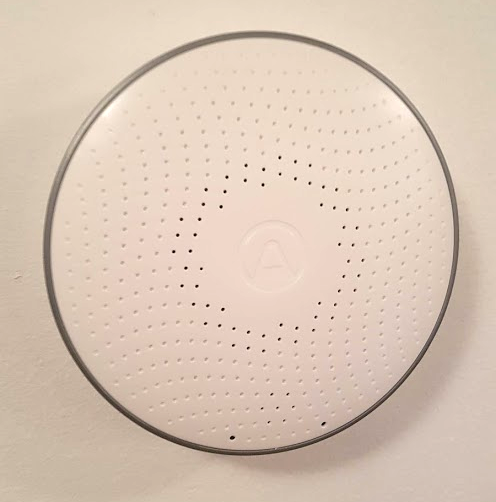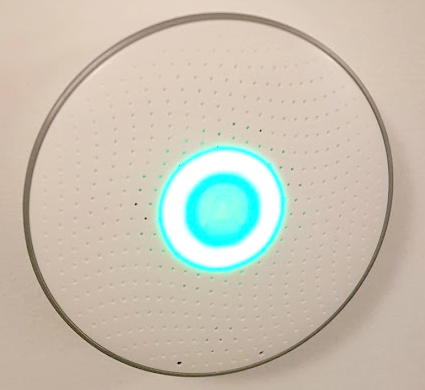Airthings Wave Plus

Airthings Wave is a bluetooth device that can monitor temperature, humidity and radon level. The “plus” model can also monitor air pressure, CO2 and VOC (Volatile organic compounds). I have had one of each model for about half a year now, so I think it is time to share my experience and thoughts about it.
I bought the Airthings wave plus because I live in a high risk radon area, and wanted to monitor the radon level in my house to get an idea about how bad it is. I wanted a device that could be connected to my home automation, and Airthings wave was actually the only device I could find.

The “wave” in the name is because you can wave your hand in front of the device and it will show a color depending on the current monitored levels. Green for good – then if goes to yellow, orange and finally red. Airthings wave connects using bluetooth to an app on your phone or tablet. The app will upload your data to a cloud service so you can see your historical data online. Not sure how often your need to do this – I think the device can hold data for several months. You can set different warnings levels in the app, so you will get a notification when you exceed these levels.
You can install a custom integration for home assistant, and connect with bluetooth from your HA server, and get the data into Home Assistant. You can get the custom integration here. The easiest way to install it is using HACS. It works fine, but the bluetooth connection can be a problem. If the device is not found at startup by the integration, the device is never added. The airthings wave plus worked out of the box. The Airthings wave was not supported because I got a 2nd edition, and this has a newer interface. I made a PR with support for 2nd edition to the guy maintaining the integration and it is now included in the current release.
Measurements
The temperature, humidity and air pressure measurements are fine. I think the update frequency is about 5 minutes. You can get very cheap devices with similar functionality, so I will not got further into this.
CO2

Here you can see the CO2 levels in my bedroom for a period of 4 days. You can see the levels get higher at night. Having both the CO2 level and ventilation in Home Assistant I can make an automation to raise the ventilation to a higher speed if the CO2 level gets too high. I have not done that because the levels are always acceptable, and I prefer to have the ventilation as quit as possible.
VOC
This measurement is not something I will be using. I am not sure exactly what gasses are being measured. The level in my house is low with a few spikes (also within low). So nothing to be concerned about.
Radon
Measuring radon levels has to be done over a longer period, so you can get an average. The fluctuations can be quite big. You can get a reading from the device once pr hour. At the beginning I had both devices in the cellar next to each other to see how it would compare. The one hour reading can be very different, the daily average is better, but the weekly average they are almost the same. Today I have the Airthing wave in my cellar and the Airthings Wave plus in the bedroom on 1 floor. When I started measuring I had levels about 300-400 Bq/m3 in my cellar – which is to high. Today after installing ventilation (your can ready about it here in another post) the levels are about 100-150Bq/m3 – still a bit high but acceptable. (These measurements are not during the summer where the levels are low <50-80 because windows and doors open a lot of the time). I have not yet measured over the winter period where the levels should be the highest. I only have half of my cellar ventilated (the part that is heated), if the levels are still to high during the next winter I may install more ventilation in the remaining part of the cellar.
Airthings hub
Airthings has made a hub so you can monitor all your Airthings devices without using the app to upload the data. This was released after I bought the devices so I have not tried this. This is a plus,but you will still be dependent of the Airthings cloud service to hold your data.
Pro
- It can measure radon levels – the only “home automation” device I have found to be able to do that.
- The wave feature is nice to get a quick status.
- Battery life is good (currently at 83% after half a year – assuming the percentage is correct)
Con
- It is expensive (1800 dkr for wave plus – 1200 dkr for wave 2)
- Bluetooth connectivity. I would have preferred WiFi or zigbee.
- You need to have the app to configured to update the device.
Bottom line is the device is fine, but if I could find one that was cheaper and using WiFi or zigbee that would have been preferred.
If you know of any similar device for measuring radon level, let me know it the comments below.
Comments
The comments below has been imported from the old website. Currently comments are readonly, meaning you can not make new comments. You will be able to do that when it is ready. For now if you want to get in touch, you can send me an email. If you have problems with something that has a github repository, please make a github issue.